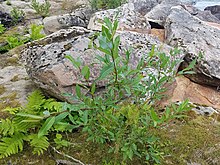Salix myricoides
| Salix myricoides | |
|---|---|

| |
| Scientific classification | |
| Kingdom: | Plantae |
| Clade: | Tracheophytes |
| Clade: | Angiosperms |
| Clade: | Eudicots |
| Clade: | Rosids |
| Order: | Malpighiales |
| Family: | Salicaceae |
| Genus: | Salix |
| Species: | S. myricoides |
| Binomial name | |
| Salix myricoides | |
| Synonyms[2] | |
List
| |
Salix myricoides, the bayberry willow or blue-leaf willow, is a species of flowering plant in the family Salicaceae, native to the Great Lakes region of the Midwestern United States, and to eastern Canada.[2][3] It is typically found on beaches and dunes of the Lakes, and occasionally along inland streams and in fens, if calcareous.[3] For example, in Maine it is found only on the ice-scoured shore of the St. John River.[4]
References
- ^ Stritch, L. (2020) [amended version of 2018 assessment]. "Salix myricoides". IUCN Red List of Threatened Species. 2020: e.T126590302A171685147. doi:10.2305/IUCN.UK.2020-2.RLTS.T126590302A171685147.en. Retrieved 1 July 2024.
- ^ a b "Salix myricoides Muhl". Plants of the World Online. Royal Botanic Gardens, Kew. Retrieved 23 September 2022.
- ^ a b Reznicek, A. A.; Voss, E. G.; Walters, B. S. (February 2011). "Salix myricoides Muhl". Michigan Flora Online. University of Michigan. Retrieved 23 September 2022.
- ^ "Salix myricoides — bayberry willow". Go Botany (3.8). Native Plant Trust. 2022. Retrieved 23 September 2022.

